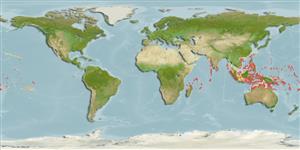Environment: milieu / climate zone / depth range / distribution range
Ökologie
seewasser riff-verbunden; tiefenbereich 3 - 30 m (Ref. 11790). Tropical; 28°N - 18°S
Indo-Pacific: East Africa to the Hawaiian and Society islands.
Size / Gewicht / Alter
Maturity: Lm ? range ? - ? cm
Max length : 10.0 cm SL Männchen/unbestimmt; (Ref. 48637)
Rückenflossenstacheln (insgesamt): 0; Rückenflossenweichstrahlen (insgesamt): 64-70; Afterflossenstacheln 0; Afterflossenweichstrahlen: 51 - 47; Wirbelzahl: 40 - 41. Body mottled brown with irregular dark and pale markings; 2-3 dark-edged ocelli along lateral line pectorals blackish distally; dorsal and anal fins with minute black dots; caudal fin with black spots (Ref. 6270). Gill rakers rudimentary (Ref. 1602).
Inhabits coral heads of lagoon and seaward reefs; common in shallow caves or under ledges and can lie flat against vertical rock surfaces (Ref. 1602, 48637). Found in rubble slopes in sand or fine-rubble patches (Ref. 9792). Benthic (Ref. 58302). Comes out at dusk and hunts on low reef. It has low profile and crawls along like a flatworm, but activity waves its black pectoral fin as it goes (Ref. 48637). Feeds on small benthic animals (Ref. 9792).
Life cycle and mating behavior
Geschlechtsreife | Fortpflanzung | Ablaichen | Eier | Fecundity | Larven
Randall, J.E., G.R. Allen and R.C. Steene, 1990. Fishes of the Great Barrier Reef and Coral Sea. University of Hawaii Press, Honolulu, Hawaii. 506 p. (Ref. 2334)
IUCN Rote Liste Status (Ref. 130435)
Bedrohung für Menschen
Harmless
Nutzung durch Menschen
Fischereien: nicht kommerziell
Mehr Information
NamenSynonymeMetabolismusRäuberÖkotoxikologieFortpflanzungGeschlechtsreifeAblaichenSpawning aggregationFecundityEierEientwicklung
ReferenzenAquakulturAquakultur ProfilZuchtlinienGenetikElectrophoresesVererbbarkeitKrankheitenVerarbeitungNutrientsMass conversion
Tools
Zusatzinformationen
Download XML
Internet Quellen
Estimates based on models
Preferred temperature (Ref.
123201): 26.7 - 29.3, mean 28.5 °C (based on 1748 cells).
Phylogenetic diversity index (Ref.
82804): PD
50 = 0.5000 [Uniqueness, from 0.5 = low to 2.0 = high].
Bayesian length-weight: a=0.01622 (0.00604 - 0.04358), b=2.94 (2.71 - 3.17), in cm total length, based on LWR estimates for this (Sub)family-body shape (Ref.
93245).
Trophic level (Ref.
69278): 3.5 ±0.37 se; based on food items.
Fishing Vulnerability (Ref.
59153): Low vulnerability (10 of 100).
Nutrients (Ref.
124155): Calcium = 97.5 [35.9, 190.1] mg/100g; Iron = 0.606 [0.264, 1.125] mg/100g; Protein = 17.8 [16.3, 19.4] %; Omega3 = 0.0866 [, ] g/100g; Selenium = 21.2 [10.0, 48.5] μg/100g; VitaminA = 150 [36, 658] μg/100g; Zinc = 1.56 [0.98, 2.38] mg/100g (wet weight);
